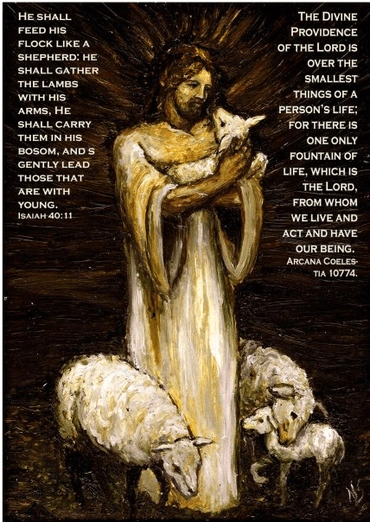8369. 'And seventy palm trees' means forms of the good of truth in like measure, that is to say, in full abundance. This is clear from the meaning of 'seventy' - like 'twelve' - as all things in their entirety, dealt with in 7973; and from the meaning of 'palm trees' as forms of good in the spiritual Church, which are forms of the good of truth. And since forms of good are meant by 'palm trees', an affection for good and the delight resulting from it are meant, for an affection for good is the source of all delight. Since 'palm trees' had this meaning they were also used in sacred festivities, such as the feast of tabernacles, in accordance with the following in Moses,
You shall take on the first day the fruit of a fine tree, 1
fronds of palm trees, the bough of a thick tree, and willows of the powerful stream; and you shall be glad before Jehovah your God seven days. Leviticus 23:40.
'The fruit of a fine tree' means celestial good, 'palm trees' spiritual good or the good of truth, 'the bough of a thick tree' truth in the form of factual knowledge, and 'willows of the powerful stream' lowest truths belonging to the natural. The four accordingly mean all forms of good and truths in their proper order.
[2] The fact that 'palm trees' were signs of sacred festivity springing from good is also clear from the following in John,
A great crowd who had come to the feast, when they heard that Jesus was coming to Jerusalem, took branches of palm trees, and went to meet Him, and cried, Hosanna! Blessed is He who comes in the name of the Lord, even the King of Israel. John 12:12-13.
And in the same author, in Revelation,
I saw, and behold a large crowd standing before the throne and before the Lamb, clothed in white robes, and palm branches in their hands. Revelation 7:9.
In Joel,
The vine has withered and the fig tree languishes, the pomegranate tree and also the palm; all joy has withered away from the sons of man. Joel 1:12.
In David,
The righteous will flourish like a palm tree; he will grow like a cedar in Lebanon. Psalms 92:12.
Here 'a palm tree' stands for good and 'a cedar' for truth.
[3] Since 'a palm tree' means good it also means wisdom, for wisdom is the discernment of good. The palm trees which were carved along with the cherubs and flowers on the walls of the temple were signs meaning such wisdom. 'The temple' meant the Lord Himself, and in the representative sense it meant heaven, 2777, 3720; 'the cherubs, palm trees, and flowers' on the walls meant providence, wisdom, and intelligence that are the Lord's, and so meant all things belonging to heaven. The fact that they were carved on the walls of the temple is clear in the first Book of Kings,
Solomon carved all the walls of the house all around with openings of carvings of cherubs, 2
and of palm trees, and with openings of flowers. And on the two doors of olive wood he carved carvings of cherubs and of palm trees, and openings of flowers, and overlaid them with gold, so that he spread gold over the cherubs and over the palm trees. 1 Kings 6:29, 32.
These 'carvings' represented the heavenly state; 'the cherubs' represented the Lord's Providence, thus the truth that all things come from Him (for the meaning of 'cherubs' as providence, see 308); 'the palm trees' represented wisdom that is a discernment of good coming from the Lord; and 'the flowers' represented intelligence that is an understanding of truth coming from Him. 'Gold' with which the cherubs and palm trees were overlaid meant the good of love, which holds sway throughout heaven (for the meaning of 'gold' as the good of love, see 113, 1551, 1552, 5658). All this also explains why in the description in Ezekiel of the new temple, meaning the Lord's heaven, it says that 'cherubs and palm trees' were on the walls everywhere, Ezekiel 41:17-18, 20, 25-26.
Fußnoten:







